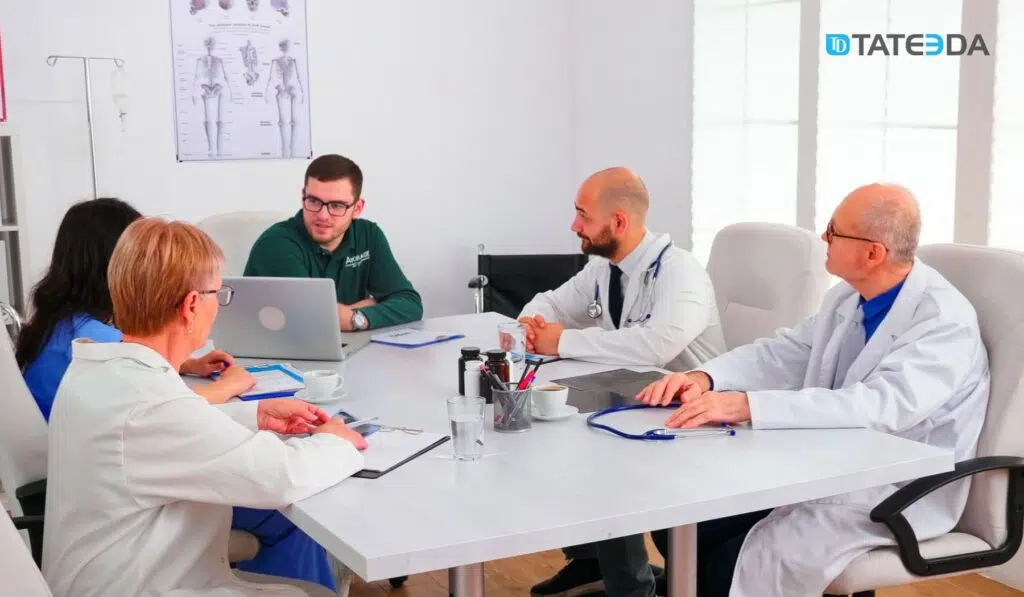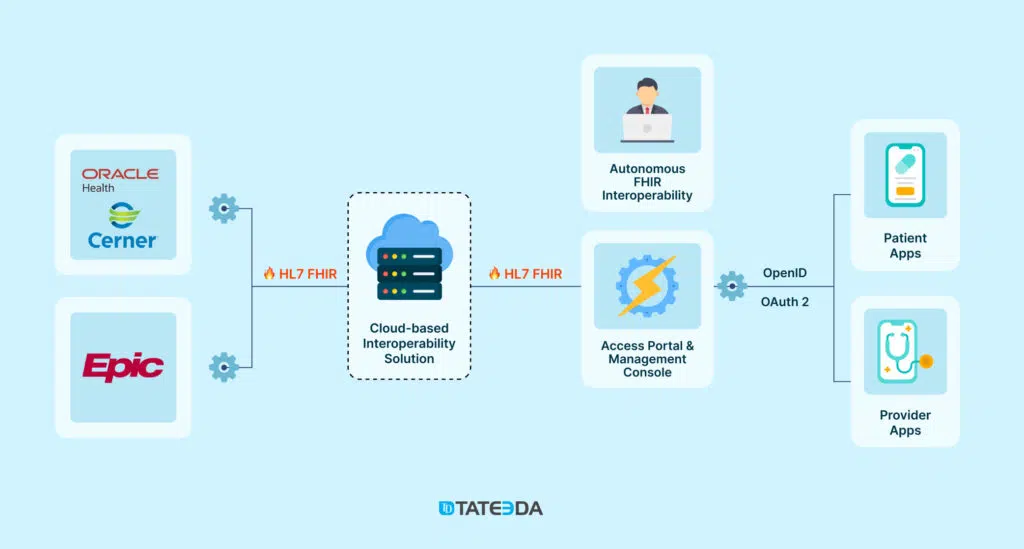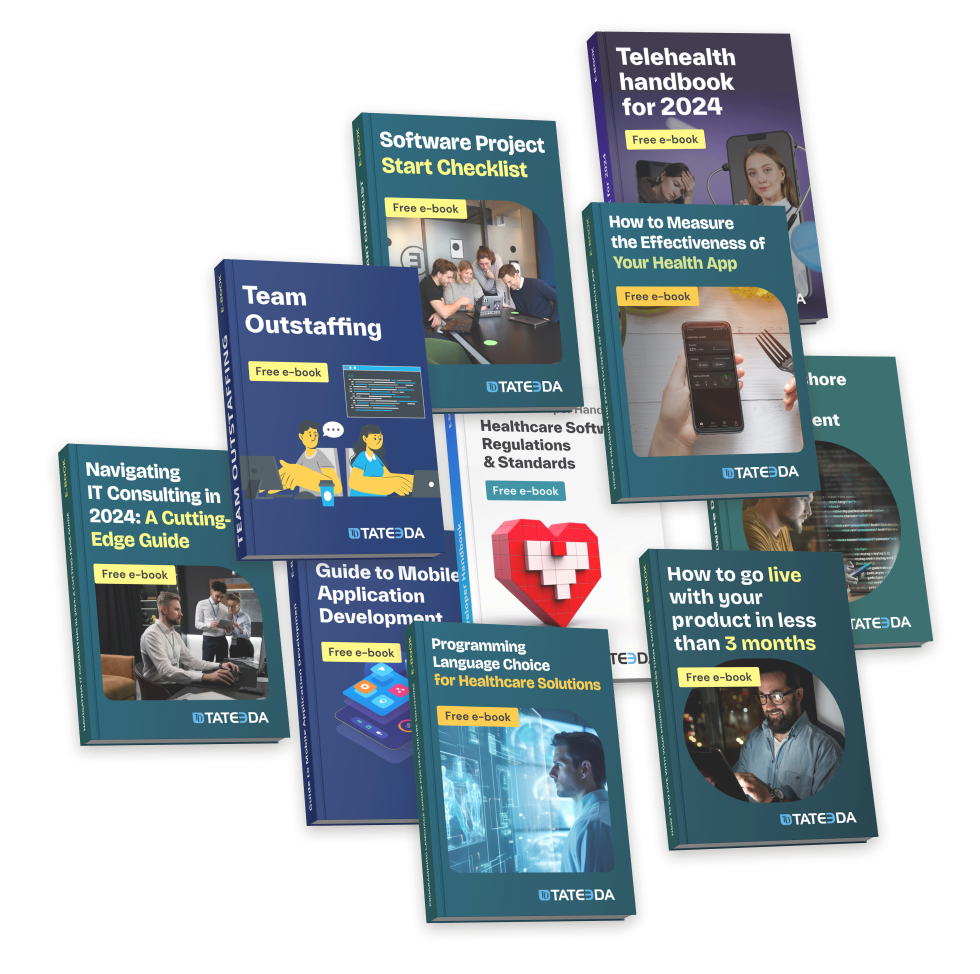How TATEEDA Helps Healthcare Clients Accelerate Product Development

Did you know that with the right approach and modern tools, you can potentially accelerate health tech product development from an average of 9–12 months down to just 3–6 months?
In this article, we’ll break down the key factors that influence development timelines when developing health tech products and explore practical strategies to accelerate health tech product development without compromising on quality or compliance.
This acceleration can be achieved by using pre-built API integrations, AI copilots, smart project structuring, and filling skill gaps with the right expertise. Teams can move from idea to launch much faster, without cutting corners.
Suppose you’re planning to start a healthcare product development project. In that case, whether it’s a patient-facing mobile app or a lightweight web platform with backend database support and third-party API integrations, you’re probably wondering how long it will take to go from concept to a working product.
Modern health tech product development tools and experienced teams can deliver a functional healthcare MVP in as little as 2 to 3 months for relatively simple applications with well-defined functionality.
On the other hand, more complex builds involving HIPAA compliance, integration with EMR/EHR systems, custom user roles, and multi-step workflows can easily stretch to 9 to 12 months or longer, especially if you’re developing health tech products that require research, UX testing, and regulatory approval.
What are the common reasons for project delays in health tech product development? 📈⛔
When several issues overlap, such as poor project management, skills gaps, or missed chances to accelerate health tech product development, even a modest healthcare app can take twice as long to build and end up costing significantly more than expected.
| Cause | Explanation | Estimated Delay | Expert Comment |
|---|---|---|---|
| Ineffective Project Management | Poor planning, unclear goals, or lack of communication can stall progress and create constant rework cycles. | 2–6 weeks or more | Outdated methods derail even strong healthcare product development. Switching to Agile sprints and roadmap acceleration, guided by experienced product managers, keeps goals focused and delivery on track. |
| Skills Gaps in the Development Team | When teams lack the right specialists (e.g., data scientists, compliance experts), progress slows due to technical bottlenecks or quality issues. | 3–8 weeks | Missing specialists, like DevOps engineers or AI developers, lead to costly delays. Using cross-functional teams and reviewing resource bandwidth early helps maintain iteration velocity and control spend. |
| Limited Budgets or Missing Resources | Insufficient funding, lack of access to necessary tools, or unplanned costs can cause interruptions and re-scoping. | 2–10+ weeks, depending on severity | Tight budgets don’t have to block progress. Low-code tools, modular design, and cloud-native architecture let solution architects build lean MVPs faster, especially in regulated health tech. |
| Poor Tech Stack Choices | Choosing tools or platforms that don’t scale, lack support, or fail to integrate easily with healthcare APIs can introduce major setbacks. | 3–6 weeks (plus rework time) | Poor choices in stack selection slow EMR/API integration. Ensuring a FHIR-ready, API-first architecture early on helps teams scale, comply, and integrate without costly rewrites. |
| Failure to Accelerate Where Possible | Teams sometimes ignore existing tools that could speed things up, like AI copilots or ready-made API integrations. | 2–5 weeks | Many teams miss clear ways to accelerate health tech product development. When set up by the right engineers and AI specialists, AI-assisted coding, pre-built modules, and CI/CD pipelines can drastically cut timelines. |
| *While this level of optimization isn’t always possible for every project, some degree of acceleration is almost always achievable, helping project owners and managers save significant time and budget. | |||
Interested in Custom Healthcare Product Development Acceleration?
Since 2013, our senior software engineering team has been helping U.S. companies accelerate health tech product development.
How to Accelerate Health Tech Product Development: 12 Proven Strategies
Speed of implementation matters when it comes to adopting the latest healthcare trends and technologies. Whether you’re building a telehealth platform, launching a new wearable, or deploying diagnostic tools, fast delivery can make the difference between competitive advantage and falling behind.
But with strict standards for regulatory compliance, HIPAA security, and FDA approval, it’s easy for health tech projects to get stuck in the planning stage.
“You don’t have to trade speed for quality. With the right tools, smart workflows, and a solid system setup, we’ve helped teams cut delays and actually accelerate health tech product development — without breaking compliance.”
— Victor I., DevOps Engineer at TATEEDA
Below are 12 proven strategies that can help any team working on healthcare product development move faster, smarter, and more confidently.
1. Start with a Strategic Health Tech Product Roadmap 🗺️📌
An effective health tech product roadmap sets priorities early and aligns your team around business-critical outcomes. Don’t try to build everything at once—focus on high-impact features that support clinical workflows or boost patient engagement right from launch.
2. Use Prebuilt APIs and Avoid Redundant Engineering 🧩🔄
One of the biggest mistakes in developing health tech products is building systems from scratch that already exist. Instead of manually coding scheduling tools, symptom checkers, or authentication layers, teams should use secure, proven APIs. These accelerate delivery, support interoperability, and allow teams to focus on custom work where it matters most—like user experience (UX) design and logic specific to your product.
3. Empower Your Dev Teams with AI Copilots 🤖💻
Tools like GitHub Copilot and other AI assistants are transforming how developers work. These copilots can write boilerplate code, generate test cases, and recommend improvements, which supports both agile development and engineering speed. For healthcare, AI copilots also help teams adhere to clean architecture and reduce bugs early in the cycle.
4. Use Modular Architecture and Scalable Components 🏗️⚙️
Modular systems allow teams to build and test independently without blocking the entire codebase. For example, a patient-facing dashboard can be developed separately from your EHR integration module. This speeds up testing, simplifies changes, and supports long-term product scalability.
5. Choose Compliance-Ready Frameworks 🔐📜
Frameworks built with HIPAA security and data privacy in mind eliminate the need for costly retrofitting. Look for vendors or open-source tools that meet regulatory compliance standards like FHIR, HL7, and SOC 2 to reduce audit friction and ensure your secure data exchange processes are already in place.

6. Outsource to Healthcare-Focused Product Teams 🤝🌍
A trusted partner for healthcare product development outsourcing can be the difference between six months of delays and a successful launch. These teams bring ready-to-use toolkits, healthcare-specific QA practices, and a deep understanding of domain standards like HIPAA or FDA approval processes and medical device software validation.
7. Fill Key Skill Gaps Early 🧠👥
In-house teams often lack experience in specific areas such as EHR integration, telehealth API orchestration, or real-time vitals tracking. Augmenting your core team with external specialists ensures you maintain quality, meet deadlines, and avoid costly rewrites down the road.
8. Design for MVP, Not for Perfection 🚀🧪
Don’t aim for a bloated, all-in-one solution at launch. A focused MVP lets you validate core assumptions quickly and iterate based on real feedback. This is especially useful in projects related to AI in healthcare, where small pilots can inform complex algorithm development and ethical deployment later on.
9. Automate Testing and Deployment with CI/CD ⚡🧪
Investing in robust DevOps from the beginning helps reduce time between iterations. Use CI/CD pipelines to automate testing, security checks, and deployments. In cloud-based healthcare solutions, this allows for fast releases with minimal risk to system integrity or uptime.
10. Align Dev Work with Clinical Impact 🎯🏥
One of the hidden challenges in healthcare product development is prioritizing low-value features. Every sprint should move the needle on clinical workflows, outcomes, or patient engagement. Tie all product decisions back to business or care delivery objectives to ensure efficient use of resources.
11. Use Real-World Feedback to Iterate 🗣️🔄
Deploy early versions to test groups of clinicians or administrators to validate assumptions before scaling. Feedback loops allow your team to fix UX pain points and optimize for real-life usage conditions across care settings.
12. Build on Secure, Cloud-Native Infrastructure ☁️🔒
Modern cloud-based healthcare solutions support elastic scaling, fault tolerance, and security monitoring. They also simplify environment replication, which is critical when deploying across large networks of providers or systems with strict data privacy regulations
Medical Solutions That Can Be Accelerated with the Right Approach
Not all health tech projects need to follow lengthy timelines. With the right planning, modern tools, and smart resource allocation, many common healthcare product development solutions can be delivered much faster than traditionally expected.
Here’s a look at some of the most frequent solution types and their typical development durations, along with how acceleration is possible.
Telehealth Platforms → Fast, Patient-centered, Custom Applications
| 🐢 Standard development time: 9+ months |
| ⏱️ With acceleration: 3–6 months |
Telehealth tech product development solutions are among the fastest-moving sectors in digital healthcare. By using pre-built modules, secure API integrations, and modern UI frameworks, telehealth apps—especially those focused on video consultations and appointment management—can be developed and deployed in a significantly shorter time frame, if done by a skilled custom telehealth development solution provider.
“Using TATEEDA’s expertise in healthcare API integrations, these telehealth and pharmacy platforms can be connected to your custom solution in a fraction of the time, typically reducing build time from 4–6 months down to just 2–3.”
— Slava K., CEO at TATEEDA
✅ Telehealth & Pharmacy Platforms TATEEDA Can Integrate
| Platform | Integration Capabilities | Website |
| Truepill | Enable real-time medication delivery and telehealth functionality via API connections built for rapid deployment | truepill.com |
| CoverMyMeds | Automate prior authorizations and streamline medication access with APIs that connect payers, EMRs, and pharmacies | covermymeds.com |
| ScriptDrop | Integrate prescription delivery into patient-facing platforms and pharmacy operations with minimal setup | scriptdrop.co |
| Doxy.me | Add video consultations and virtual visit scheduling to your solution through HIPAA-compliant telehealth APIs | doxy.me |
| Teladoc | Connect to an enterprise-grade virtual care ecosystem with scalable APIs for EMR, insurance, and telehealth workflows | teladoc.com |
| Amwell | Deploy robust telehealth features and insurance integrations through APIs tailored for enterprise medical platforms | amwell.com |
| MDLive | Embed telemedicine features such as online visits and payer integration into your application with ease | mdlive.com |
| Ro | Build direct-to-consumer health tools with APIs covering virtual care, pharmacy fulfillment, and subscription services | ro.co |
| Surescripts | Connect e-prescribing and medication data directly to EMRs, pharmacy systems, and insurance platforms | surescripts.com |
| RxSense | Integrate pharmacy benefit data and billing logic into digital health apps using modern insurance APIs | rxsense.com |
| Medication Management Systems (MMS) | Configure pharmacy billing and insurance integration with APIs built for medication workflow optimization | medmansys.com |
EHR Integration Projects → Swift and Reliable Data Management
| 🐢 Standard development time: 12+ months |
| ⏱️ With acceleration: 4–7 months |
Integration with existing EHR systems like Epic, Cerner, or Athenahealth can be time-consuming due to complexity and compliance requirements. However, using tested interoperability protocols (like FHIR) and existing middleware tools can significantly reduce both development and validation time.

✅ EHR Platforms TATEEDA Can Help You Integrate
| EHR System | Integration Capabilities | Website |
| Epic Systems | Access clinical and billing data through App Orchard APIs with robust support for AI tools and EMR workflows | epic.com |
| Cerner (Oracle Health) | Build powerful integrations via Cerner Code APIs for clinical analytics, insurance syncing, and medical records | oracle.com/cerner |
| Athenahealth | Use cloud-based APIs to enable documentation automation, claims processing, and EMR data exchange | athenahealth.com |
| Allscripts (Veradigm) | Connect to predictive analytics, billing systems, and EMRs via their open developer ecosystem | veradigm.com |
| eClinicalWorks | Enable AI features and real-time updates across EMRs, billing platforms, and patient engagement tools | eclinicalworks.com |
| Meditech | Automate clinical workflows and connect core systems with Expanse APIs tailored for hospitals and clinics | meditech.com |
| NextGen Healthcare | Integrate AI-powered clinical decision support, RCM tools, and EMR data across departments | nextgen.com |
| Greenway Health | Synchronize patient engagement data, claims, and EMR content with modern interoperability APIs | greenwayhealth.com |
| DrChrono | Build lightweight, AI-enhanced integrations for mobile-friendly EMR, billing, and scheduling workflows | drchrono.com |
| AdvancedMD | Create seamless workflows across EMR, billing, and insurance using their practice-focused APIs | advancedmd.com |
| Practice Fusion (Veradigm) | Implement scalable, cloud-native links for EMR syncing, claims submission, and reporting | practicefusion.com |
| PointClickCare | Connect long-term care data with revenue and EMR systems via specialized APIs | pointclickcare.com |
| WebPT | Support therapy-focused workflows by integrating AI reporting, EMR content, and billing solutions | webpt.com |
| MatrixCare | Enable smoother senior care coordination through EMR, insurance, and financial integrations | matrixcare.com |
| CareCloud | Optimize revenue cycle performance and patient data flow with cloud-based, AI-ready APIs | carecloud.com |
| Valant | Integrate behavioral health insights, insurance claims, and EMR records with minimal friction | valant.io |
| OpenEMR | Customize open-source healthcare workflows with flexible EMR, billing, and insurance APIs | open-emr.org |
| Tebra | Link medical practice management tools, AI workflows, and clinical data in one unified system | tebra.com |

AI in Healthcare Applications → Smarter, Faster, Compliant Integrations
| 🐢 Standard development time: 9–12+ months |
| ⏱️ With acceleration: 5–8 months |
From AI-powered triage to clinical decision support systems, today’s AI tools are powerful. However, they are also data-heavy and integration-intensive. To accelerate health tech product development, teams can use pretrained models, proven ML frameworks, and trusted generative AI assistant development solutions. These are especially effective when tailored to specific clinical use cases.
AI is also showing strong potential in biotechnological projects. It can be applied in drug discovery, genetic analysis, and personalized treatment modeling. These tools help automate complex workflows and speed up research cycles.
AI is advancing quickly in medical diagnostics. It supports radiology, pathology, and predictive analytics. AI agents can assist clinicians with faster insights and improve diagnostic accuracy and efficiency across the care continuum.
“Healthcare staff shortages aren’t going away overnight—but AI integration services can give human front-desk teams a breather. Voice agents and generative AI bots now handle the majority of patient interactions smoothly and naturally. The result? Operators step in only when it counts, and even then, AI has already done 80–90% of the heavy lifting.”
— Andrew G., Senior Software Developer at TATEEDA
Many of the most common challenges in healthcare product development (from data silos to time-consuming compliance checks) can be solved more efficiently with modular systems, FHIR-compliant APIs, and cloud-based workflows. With the right specialists, healthcare product development outsourcing enables faster deployment while maintaining quality and regulatory alignment.
✅ AI & Analytics Platforms TATEEDA Can Integrate
| Platform | Core Integration Capabilities | Website |
| IBM Watson Health | AI for clinical decision support with APIs for EMR and insurance analytics | ibm.com/watson-health |
| Google Cloud Healthcare API | FHIR and imaging APIs for EMR, insurance, and AI-powered data analytics | cloud.google.com/healthcare |
| Microsoft Azure Healthcare APIs | APIs for clinical workflows, insurance, and FHIR-compliant AI services | azure.microsoft.com |
| Nuance (Microsoft) | AI-driven clinical documentation integrated with EMRs and billing platforms | nuance.com |
| Tempus | Precision medicine AI with APIs for clinical insights and EMR data processing | tempus.com |
| PathAI | Pathology diagnostic AI with seamless EMR and imaging API support | pathai.com |
| Aidoc | Radiology AI workflows with APIs for EMR and real-time imaging analytics | aidoc.com |
| Viz.ai | Stroke detection AI with EMR-connected clinical decision support APIs | viz.ai |
| Butterfly Network | AI ultrasound imaging with real-time EMR and diagnostics integration | butterflynetwork.com |
| Olive AI | Healthcare automation AI with APIs for billing, insurance, and EMRs | oliveai.com |
| KenSci | Predictive analytics with APIs for EMR and insurance-based forecasting | kensci.com |
| Infermedica | Symptom checking AI with EMR-linked triage automation APIs | infermedica.com |
| Prognos Health | Predictive analytics for EMR, clinical insights, and insurance data | prognoshealth.com |
| Health Catalyst | AI-backed data warehousing with EMR, billing, and compliance-ready APIs | healthcatalyst.com |
| Komodo Health | Large-scale analytics with APIs for healthcare data and insurance tracking | komodohealth.com |
| Clarify Health | Insurance and EMR analytics with enterprise-grade healthcare APIs | clarifyhealth.com |
| Arcadia | Integrated analytics platform with APIs for EMR and payer systems | arcadia.io |
| Apixio | AI-enhanced healthcare analytics with APIs for EMR and risk adjustment | apixio.com |
| ClosedLoop.ai | AI development platform with APIs for clinical data and insurance analytics | closedloop.ai |
| Suki AI | Voice-based assistant APIs for medical note creation and billing integration | suki.ai |
| Ambient.ai | Ambient clinical intelligence with real-time EMR integration APIs | ambient.ai |
| Notable Health | AI-powered automation tools with APIs for EMR, billing, and admin workflows | notablehealth.com |
| Lunit | Medical imaging AI with EMR and diagnostic system integration | lunit.io |
| Arterys | AI for radiology and cardiology with clinical workflow API integrations | arterys.com |
| Enlitic | AI-powered medical imaging with APIs for diagnostics and EMR | enlitic.com |
| Imagen | Diagnostic AI with APIs for image interpretation and EMR workflows | imagen.io |
| Qventus | AI-driven operations management with EMR and billing automation APIs | qventus.com |
| LeanTaaS | Scheduling and capacity management AI with EMR-connected APIs | leantaas.com |
Healthcare Staffing Management Software Development → Smarter Scheduling, Safer Shifts
| 🐢 Standard development time: 12+ months |
| ⏱️ With acceleration: 7–9 months |
From severe staff shortages to burnout, managing healthcare teams efficiently has never been more critical in the United States. Hospitals and clinics need custom healthcare staffing management solutions encompassing AI-enhanced tools that unify credential tracking, onboarding, licensing, HR processes, and time tracking, while ensuring regulatory compliance, data privacy, and integration with EHR systems.
TATEEDA helps build intelligent, all-in-one staffing management platforms completely valid in terms of HIPAA regulations. They eliminate fragmented workflows, automate medical staff scheduling, and give hospital or agency administrators real-time visibility into staff availability and performance. These solutions reduce manual errors, improve shift coverage, and allow teams to focus on care, not coordination.
🔁 Common Integrations for Staffing, Training & Operational Intelligence
| Platform | Integration Capabilities | Website |
| Automation Anywhere | RPA-powered bots that automate repetitive staffing and scheduling workflows via Epic and EHR APIs | automationanywhere.com |
| Salesforce Health Cloud | CRM tools with provider data, shift coordination, and patient engagement features for workforce visibility | salesforce.com/health-cloud |
| Navinet | Enhances staff collaboration through real-time insurance and billing coordination APIs | navinet.net |
| Edifecs | EDI and compliance automation supporting staff documentation and insurance alignment | edifecs.com |
| Inovalon | Analytics for workforce efficiency, credential monitoring, and billing staff performance insights | inovalon.com |
| TeleTracking (Central Logic) | Patient throughput and bed capacity tools with APIs supporting nurse staffing models | centrallogic.com |
| Kyruus Health | Ensures accurate provider directories and staff scheduling through smart EMR-integrated APIs | kyruus.com |
| Phynd (symplr) | Centralizes provider data and integrates with HR systems for accurate shift allocation | symplr.com |
| HealthStream | Delivers workforce education tracking and clinical credential management with EMR compatibility | healthstream.com |
| MedTrainer | Compliance and certification tracking for clinical staff, integrated directly into EMR workflows | medtrainer.com |
| NetLearning (HealthStream) | LMS platform that manages required training and role-specific onboarding workflows | healthstream.com |
| Relias | Training and compliance support for nurses, aides, and administrative staff via EMR-linked APIs | relias.com |
| Collective Medical (PointClickCare) | Supports staff coordination in value-based care and care transitions with EMR-integrated tools | pointclickcare.com |
| PatientPing | Real-time care alerts that notify staff of patient movement and admission status changes | patientping.com |
| Civitas Solutions (WellSky) | Supports shift planning and documentation in community care settings through EMR integration | wellsky.com |
| Workday Healthcare | HR and payroll systems integrated with clinical scheduling and staff analytics platforms | workday.com |
| SAP Healthcare | Enterprise-grade workforce and asset planning with seamless EHR and billing integrations | sap.com/industries/healthcare |
| Oracle Health Sciences | Adds scheduling logic for clinical trials, lab staffing, and operational reporting | oracle.com/health-sciences |
| Accenture Health | Offers tailored consulting for workforce optimization tools, including API-driven integrations | accenture.com |
| Deloitte Health Care | Delivers strategy and implementation for staffing intelligence platforms integrated with EMRs | deloitte.com/health-care |
Medical Device Software
| 🐢 Standard development time: 10–14 months |
| ⏱️ With acceleration: 6–8 months |
Developing software for medical devices involves strict validation protocols, comprehensive testing, and frequently, the need for FDA approval. While these steps are essential for ensuring patient safety and regulatory compliance, they can significantly extend the project timeline.
That said, accelerating product development in healthcare is entirely feasible. By adopting a modular software architecture, incorporating pre-approved components, and preparing regulatory documentation early in the process, development teams can reduce friction and avoid common delays.
Establishing secure data exchange frameworks from day one further supports compliance and streamlines integration across clinical systems.
✅ Devices that Often Require Custom Software Solutions:
| Device Type | Functionality & Software Needs |
| Remote Patient Monitoring Systems | Collect vitals and transmit real-time data to clinical dashboards for physician review |
| Wearable Health Trackers | Sync with mobile apps to support patient engagement, activity logging, and reporting |
| Portable Diagnostic Devices | Enable home monitoring of blood pressure, glucose, or oxygen levels, connected to provider systems |
| Smart Inhalers & Injectors | Track medication usage and send compliance data directly to healthcare professionals |
| Digital Pill Dispensers | Alert patients and caregivers while logging dosage history for adherence tracking |
| Rehabilitation & Physiotherapy Tools | Provide guided exercises and real-time feedback through mobile or desktop interfaces |
| Connected Medical Imaging Equipment | Integrate with PACS or EMR platforms to securely share diagnostic imaging data |
Medical Insurance & Payer APIs → Connected, Compliant, and Scalable Payment Tools
| 🐢 Standard development time: 7+ months |
| ⏱️ With acceleration: 4–6 months |
Accelerating health tech product development means streamlining every touchpoint — and that includes seamless connections to major payer and custom healthcare insurance systems. Whether you’re building a billing module, patient portal, or claims processing feature, API-based connectivity with national and regional payers is essential.
With TATEEDA’s expertise in healthcare product development outsourcing, we help you eliminate complexity by integrating your solutions with trusted payer APIs, ensuring real-time eligibility checks, faster claims processing, and tighter alignment between providers and insurers.
By addressing common challenges in healthcare product development, like fragmented billing workflows and payer delays, our engineering team implements scalable, FHIR-compliant, and secure integrations designed for speed and interoperability.
✅ Medical Insurance & Payer Platforms TATEEDA Can Integrate
| Platform | Integration Capabilities | Website |
| Optum | Payer/provider APIs for eligibility, claims, and AI-enhanced billing and insurance analytics | optum.com |
| UnitedHealthcare | Claims and benefit management APIs for insurance, billing automation, and member services | uhc.com |
| Humana | Health insurance APIs supporting billing workflows, claims validation, and care cost estimation | humana.com |
| Aetna (CVS Health) | Payer and pharmacy APIs for coverage, claims, and EMR-linked billing functions | cvshealth.com |
| Cigna | Global health APIs for provider workflows, insurance claims, and real-time billing status | cigna.com |
| Elevance Health (Anthem) | Insurance and member management APIs for benefit coordination and claims tracking | elevancehealth.com |
| Blue Cross Blue Shield | Regional payer APIs for insurance verification, billing cycles, and claims processing | bcbs.com |
| Oscar Health | Digital-first insurance APIs for billing, claims filing, and proactive member engagement | oscarhealth.com |
| Clover Health | Medicare Advantage APIs for claims data, care coordination, and reimbursement workflows | cloverhealth.com |
| Devoted Health | Senior care insurance APIs focused on billing, claims optimization, and EMR sync | devoted.com |
| Alignment Healthcare | APIs for senior health plan integration with billing engines, care management tools, and insurance validation | alignmenthealthcare.com |
| HealthEdge | Comprehensive payer solution APIs for EMR integration, billing, and insurance platform automation | healthedge.com |
Custom Hospital Management Solution Development → Secure Medical Record Operations
| 🐢 Standard development time: 12+ months |
| ⏱️ With acceleration: 7–9 months |
The demand for intelligent, scalable, and regulation-ready digital infrastructure is growing rapidly in modern healthcare. Whether managing hospital beds, streamlining admissions, or tracking pharmaceuticals, the need for high-performance systems is more critical than ever.
Custom hospital management software development plays a central role in solving key challenges across facilities of all sizes. From optimizing clinical workflows to ensuring data privacy, today’s hospital systems must support not only core functionality but also regulatory compliance, seamless interoperability, and robust HIPAA security from day one.
As a hospital management software development company, TATEEDA understands the complex needs of healthcare institutions. We help clients streamline the health tech product development lifecycle by integrating secure, scalable technologies that comply with FDA approval standards and enable efficient EHR integration across departments.
Whether you’re developing health tech products to improve operational transparency, boost patient care, or expand telehealth capabilities, selecting the right software strategy and integration platform is key.
🔌 Common Integration Platforms for Hospital Software Solutions
| Platform | Integration Capabilities | Website |
| Redox | Enables hospitals to connect EHRs, billing, and insurance systems through a unified interface for smoother operations and fewer integration headaches | redoxengine.com |
| Health Gorilla | Facilitates secure FHIR-based health data sharing across departments, labs, and external providers for diagnostics and insurance coordination | healthgorilla.com |
| 1upHealth | Simplifies access to patient health records, EMR data, and insurance details with FHIR APIs optimized for large-scale hospital systems | 1up.health |
| Lyniate | Powers clinical and financial data exchange with Corepoint and Rhapsody engines to support hospital-wide system interoperability | lyniate.com |
| Bridge Connector | Provides no-code tools to sync hospital software, like EMRs, pharmacy systems, and claims processing, without custom coding | bridgeconnector.com |
| Particle Health | Helps hospitals retrieve verified patient records from multiple sources for admissions, treatment planning, and coordinated care | particlehealth.com |
| Innovaccer | Consolidates EMR, payer, and operational data to help hospitals optimize care delivery, performance analytics, and resource use | innovaccer.com |
| MuleSoft (Salesforce) | Connects hospital data across departments and vendors, making it easier to automate workflows and reduce data silos | salesforce.com/mulesoft |
| InterSystems | Offers real-time integration for EMR, billing, and insurance data—ideal for hospital networks managing large patient volumes | intersystems.com |
| Mirth Connect (NextGen) | Acts as a central integration hub for managing hospital data transfers between EHRs, labs, and third-party billing tools | nextgen.com |
| Human API | Collects and delivers patient health data from various providers to improve hospital decision-making and reduce intake delays | humanapi.co |
| Smile CDR | Delivers fast, secure FHIR server infrastructure to help hospitals enable compliant, scalable patient data exchange | smilecdr.com |
| Firely (Vonk) | Provides flexible FHIR API tools for hospitals building modern, standards-based integrations between departments and payers | fire.ly |
| HAPI FHIR | Open-source FHIR toolkit used by hospitals to create custom integrations for billing, records access, and data validation | hapifhir.io |
| PokitDok (Oracle) | Supports insurance claims, pre-authorizations, and EMR syncing for smoother financial workflows in hospital settings | oracle.com |
| OnBase (Hyland) | Manages healthcare documentation across billing, EMRs, and compliance workflows, keeping hospital data centralized and secure. | hyland.com |
Cloud-Based Healthcare Platforms
| 🐢 Standard development time: 6–8 months |
| ⏱️ With acceleration: 3–4 months |
Cloud-native apps—such as data dashboards, patient portals, or analytics tools—can be built faster with cloud providers like AWS, Azure, or Google Cloud. Pre-configured healthcare APIs and infrastructure-as-code approaches help teams scale securely and speed up deployment.
Can Healthcare Product Development Outsourcing Accelerate the Project Execution?
Absolutely. It’s one of the most practical ways to move faster without sacrificing quality. Among the top challenges in healthcare product development are tight timelines, scattered technical decisions, and limited in-house resources. These factors often lead to delays, budget overruns, and stalled MVPs.
That’s where outsourcing comes in. A skilled partner can simplify the healthcare product development process by providing dedicated cross-functional teams, modern infrastructure, and a clearer path to regulatory compliance.
“Before TATEEDA stepped in, the client had been struggling with delays on what should’ve been a straightforward health tech product. The app wasn’t complex, but process gaps and unclear ownership led to serious staff burnout, frustration, and spiraling costs. After a short project audit, we helped restructure their development roadmap and doubled their delivery speed. Code performance also improved significantly thanks to focused backend refactoring and smarter CI/CD deployment.”
— Anastasia M., Healthcare Project Lead at TATEEDA
Outsourced teams aren’t just extra hands—they bring in proven assets that help you move quickly and stay focused. These include:
- Prebuilt integration layers for EHR/EMR systems
- Cloud-native infrastructure setups (AWS, Azure, GCP)
- Automated testing and CI/CD pipelines
- Deployment-ready AI/ML components
- DevOps and MLOps optimization
- Modular software architecture and FHIR-ready data flows.
These tools make it possible to reduce tech debt early, optimize delivery cycles, and accelerate testing and iteration.
So, if you’re asking why outsource healthcare product development, the answer is clarity, speed, and scale. With the right partner, you not only meet your deadlines, you also build smarter.
The Final Word
The process of developing health tech products doesn’t need to be slow, expensive, or chaotic. With the right approach, teams can dramatically shorten timelines, reduce budget strain, and build better solutions faster.
When done right, these 12 strategies reduce many of the classic delays seen across the healthcare product development process. Whether you’re an early-stage startup or a growing medtech company, strategic execution backed by technical excellence makes all the difference.
At TATEEDA, we specialize in helping healthcare organizations accelerate digital transformation by providing custom development teams, healthcare-focused engineers, and proven frameworks that support security, compliance, and real-world care delivery.
If you’re facing timeline pressures or struggling with scope, now may be the time to rethink your stack, your structure, and possibly your partners. After all, accelerating health tech product development isn’t just about speed. It’s about building the future of care before someone else does. Contact us today!









